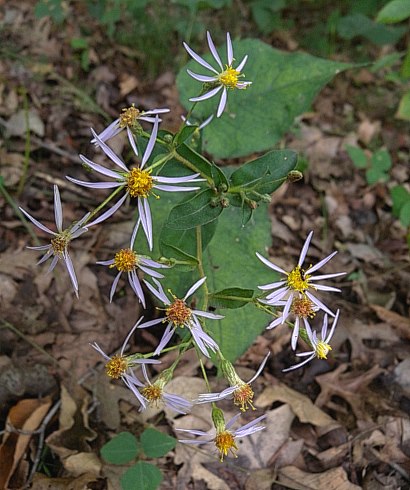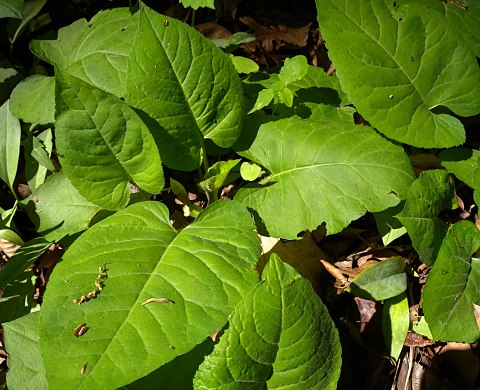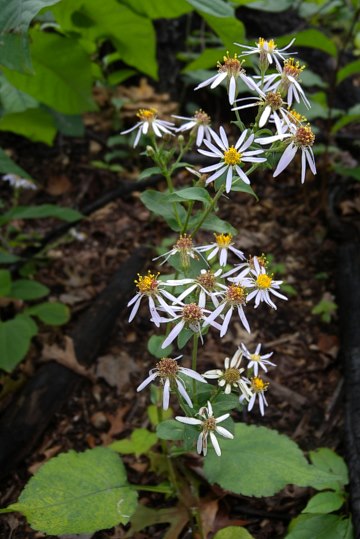
The upper central stem of each plant (and any upper lateral stems) terminates in a flat-headed panicle (corymb) of flowerheads spanning 3-8" across. Individual flowerheads are ½-1¼" across, consisting of 8-20 ray florets that surround numerous disk florets. The petal-like corollas of the ray florets are lavender or white. The tubular corollas of the disk florets are initially pale yellow or yellow, but they later become orange-red, dark red, or brown. The tubular corolla of each disk floret has 5 slightly spreading lobes at its apex. At the base of each flowerhead, there are numerous floral bracts (phyllaries) that are arranged in 4-6 series; they are appressed and overlapping. Individual floral bracts are more or less oblong in shape and mostly green, except for the narrow white margins along their sides; they are short-pubescent and occasionally ciliate along their margins. The tips of these bracts are usually blunt; less often, they are somewhat pointed. The peduncles and pedicels of the panicle are light green, relatively stout, and covered with short glandular hairs. At the base of each branch of the panicle, there is usually a single leafy bract up to 1½" long that is broadly oblong or broadly elliptic; these bracts are sessile.

The blooming period occurs from late summer to early fall and lasts about 1-1½ months. During the autumn, both ray and disk florets are replaced by small bullet-shaped achenes; each achene has a tuft of tawny hairs at its apex. The achenes are distributed by the wind. The root system is fibrous and long-rhizomatous; on older plants, a small caudex sometimes develops. This wildflower often forms clonal colonies by means of the spreading rhizomes.
Cultivation: The preference is partial sun to medium shade, moist to dry-mesic conditions, and soil consisting of rich loam or sandy loam.
Faunal Associations: The nectar and pollen of the flowers attract a large variety of insects, including long-tongued bees, short-tongued bees, wasps, flies, butterflies, beetles, and plant bugs. An oligolectic Andrenid bee, Andrena hirticincta, has been observed visiting the flowerheads of Big-Leaved Aster (see Graenicher). Other insects feed on the foliage and flowers, suck plant juices, or bore through the stems and roots of this aster and others. Examples of such insect feeders include caterpillars of the butterflies Chlosyne nycteis (Silvery Checkerspot) and Phyciodes tharos (Pearl Crescent); also the caterpillars of Carmenta corni (Aster Borer Moth), Cucullia asteroides (The Asteroid), Schinia arcigera (Arcigera Flower Moth), and other moths feed on asters (see Moth Table). Other insects feeders include the larvae of Calycomyza humeralis (Aster Leafminer Fly), several aphids (mostly Uroleucon spp.), Macrosteles quadrilineatus (Aster Leafhopper), the lace bugs Corythucha marmorata and Galeata spinifrons, the leaf beetles Exema canadensis and Ophraella pilosa, the plant bug Plagiognathus cuneatus, and others (see Insect Table for a more complete listing of species). Some vertebrate animals use asters as a food source. The Ruffed Grouse and Wild Turkey eat the seeds and foliage, while the White-Tailed Deer and Cottontail Rabbit sometimes browse on the foliage. The foliage is also edible to cattle, sheep, and other domesticated farm animals.
Photographic Location: The photograph of the basal leaves was taken at a deciduous woodland in NW Ohio, while the photographs of the flowerheads were taken at a woodland border and a sandy oak savanna in the Indiana Dunes State Park, NW Indiana.

Comments: Sometimes Big-Leaved Aster is referred to as Aster macrophyllus. The large basal leaves of this aster are very conspicuous during the spring. During the autumn, Big-Leaved Aster resembles many other woodland asters and it is more difficult to identify. However, it can be distinguished from similar species by the appearance of its floral bracts (phyllaries), the presence of short glandular hairs on its peduncles and pedicels (a 10x hand lens may be required), and the flat-headed characteristic of its panicles. Most asters have elongated panicles of flowerheads that are not flat-headed. A species that is not found in Illinois, Eurybia divaricata (White Wood Aster), shares this flat-headed characteristic with Big-Leaved Aster and its leaves have a similar shape. However, White Wood Aster has flowerheads with fewer ray florets (about 5-10), its peduncles and pedicels usually have non-glandular hairs, and its basal leaves are smaller in size.